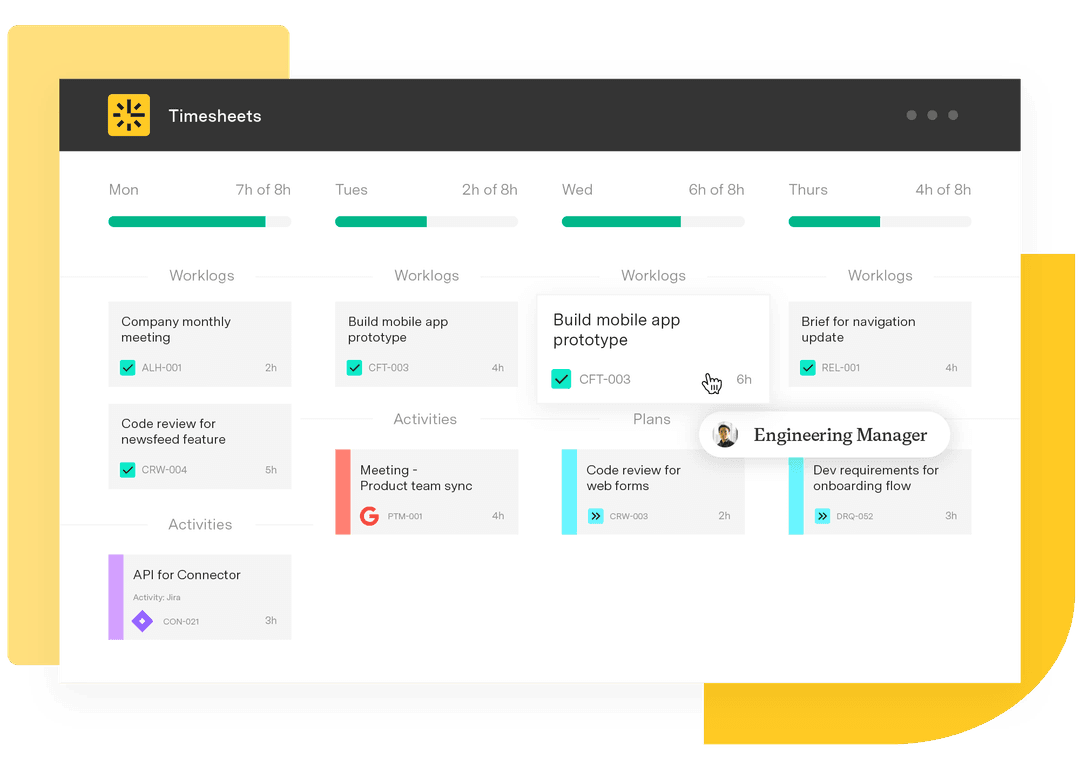What is a PIP? Performance improvement plans explained
Tempo Team
No one sets out to underperform at work. But sometimes, despite the best intentions, things slip through the cracks. Employees miss deadlines, fall short of expectations, or require structured feedback.
That’s where a performance improvement plan (PIP) can help. A PIP helps employees course-correct by outlining clear expectations, support systems, and a structured path toward improvement. When done right, it avoids punishment in favor of facilitating progress for the individual and their team.
Here, you’ll learn what a PIP is, when it’s necessary, and how to create one that’s fair and effective.
What is a performance improvement plan (PIP)?
A performance improvement plan (PIP) is a formal document outlining areas where an employee’s performance isn’t meeting expectations and solutions to correct the issue. It’s a tool designed to help employees improve and succeed, with clear goals, a timeline, and the support they need to make real progress. A well-executed PIP goes beyond critiquing past performance to encourage collaboration between the employee and the company.
PIPs often focus on general concerns like meeting deadlines, improving communication, or increasing work output, but they can be as specific as needed. The goal is to create an actionable plan that leads to real change. A PIP should provide precise, achievable, and realistic expectations that offer a chance to improve.
When is a PIP needed?
Everyone has a bad day at work once in a while. However, employees who exhibit a pattern of underperformance may need a more structured response. Here are some situations where a PIP might be necessary:
Chronic missed deadlines or deliverables: Occasional delays are inevitable, but someone who consistently misses deadlines and impedes the team’s momentum may require dedicated attention.
Failure to meet performance goals: Whether an employee is missing KPIs, quotas, or internal benchmarks, a consistent gap between expectations and output indicates that additional support and structure are needed.
Frequent quality issues: If work regularly requires revision, misses key details, or falls short of company standards, a PIP can set clearer expectations and raise the bar.
Ongoing negative feedback: Complaints could come from clients or direct managers and might relate to poor communication or unreliability. An improvement plan becomes necessary when the same concerns surface time after time.
Difficulty adapting to role changes: Sometimes, shifting responsibilities or new leadership create growing pains. A PIP can offer guidance and tools to bridge that gap.
How to create a performance improvement plan
A performance improvement plan should be a fair, structured action plan that prioritizes accountability and clarity. An effective PIP gives the employee a chance to get back on track and succeed in their role.
Here’s how to draft and roll out a plan that meets employee needs and business goals:
1. Draft the improvement plan with clear expectations
Start by pinpointing what’s not working. Is the employee consistently missing deadlines? Struggling with communication? Not meeting performance goals laid out in their most recent review?
Use this core concern to formulate clear, measurable, and achievable objectives. For example, instead of asking the employee to “improve productivity,” request that they “submit weekly project reports by Friday at noon for the next four weeks.”
In a comprehensive performance improvement plan, examples can further clarify expectations. By specifying the terms of success, you eliminate confusion.
2. Have HR review the plan for alignment and fairness
The PIP’s meaning in HR is to support improvement, not to fast-track termination. Before sharing the PIP with the employee, send a draft to human resources so they can verify that the plan is legally sound, aligns with your performance management process, and doesn’t unintentionally set the employee up to fail.
3. Present the plan to the employee in a private meeting
Next, sit down with the employee in a discreet, private setting to explain the reasons for the PIP. Deliver your constructive criticisms in a straightforward but supportive tone, and avoid framing the plan as punitive.
The employee may not immediately know how to respond to a PIP. Walk them through each element of the plan while allowing them space to react and ask questions. The goal is to invite them into the improvement process and give them a say in how to move forward.
4. Provide continuous support and resources
A performance plan shouldn’t tell employees to “figure it out or fail.” People are more likely to rise to the occasion when they feel like they aren’t facing it alone. The best performance improvement plans include regular encouragement and tools that meet the employee’s needs. They should come with robust support, whether that means coaching from a supervisor, access to training, or mentoring to build strengths and boost work productivity.
5. Track progress with regular check-ins
Implement recurring check-ins to measure improvements and provide timely feedback. These conversations should focus on what’s working, where adjustments are needed, and how the employee can apply lessons to real project work.
Employees worried about how to survive a PIP often just need structure, encouragement, and a fair chance. A well-executed performance plan offers all of that and more.
Benefits of implementing a PIP
A performance improvement plan is a chance for employees to hit reset, realign with their goals, and get the support they need to succeed. For managers, it’s a powerful tool to strengthen teams and improve overall performance.
Here’s what makes a well-implemented PIP so valuable:
Encourages accountability and self-awareness
A PIP clearly outlines the necessary improvements, how to achieve them, and what success looks like. Seeing these expectations written down in a structured document can be eye-opening for many employees. It encourages ownership and helps them reflect on how they can exceed their performance goals.
Opens the door to honest communication
Although it can be challenging to navigate, a performance improvement plan allows for candid, two-way conversations. Managers get a chance to outline their concerns, and employees have a moment to ask questions and understand the bigger picture. This open dialogue can strengthen trust and improve day-to-day working relationships.
Gives people a fair chance to succeed
Not every underperformance issue results from laziness or lack of skill. Sometimes, people simply need clearer direction, better support, or more time. A fair, thoughtful PIP allows the employee to regroup and rebuild. It’s a reminder that the company wants them to succeed and become stronger.
Supports continuous feedback and coaching
Performance management isn’t a one-time event. Effective PIPs introduce a rhythm of consistent check-ins and coaching moments that help employees stay on track. When done well, they shift the workplace culture toward growth.
Helps uncover hidden strengths
Although a PIP focuses on what needs fixing, it can also reveal what someone is good at. Through the improvement process, employees may discover new ways to apply their skills to project work, increase work productivity, or even take on new roles that better align with their strengths.
Provides a clear process and reduces risk
It’s critical that HR and leadership develop a formal and consistent approach to address underperformance. A documented performance plan protects both the employee and the employer by demonstrating a structured attempt to support improvement before considering termination or other disciplinary action.
Supporting employee growth and performance with Tempo
A performance improvement plan is only as effective as the tools that support and track it. Even the most thoughtful action plan can fall short without visibility into where time is spent or how efforts connect to results.
Tempo’s Jira-enabled Timesheets application helps managers and employees get a clear view of how they spend time, so teams stay focused, accountable, and aligned with their performance goals. Meanwhile, Custom Charts for Jira measures and visualizes progress, swapping vague feedback for actionable insights.
Tempo provides clarity, structure, and support to help employees and managers exceed expectations. Try Tempo today and give your team the tools to thrive.













































